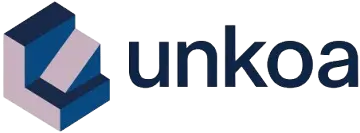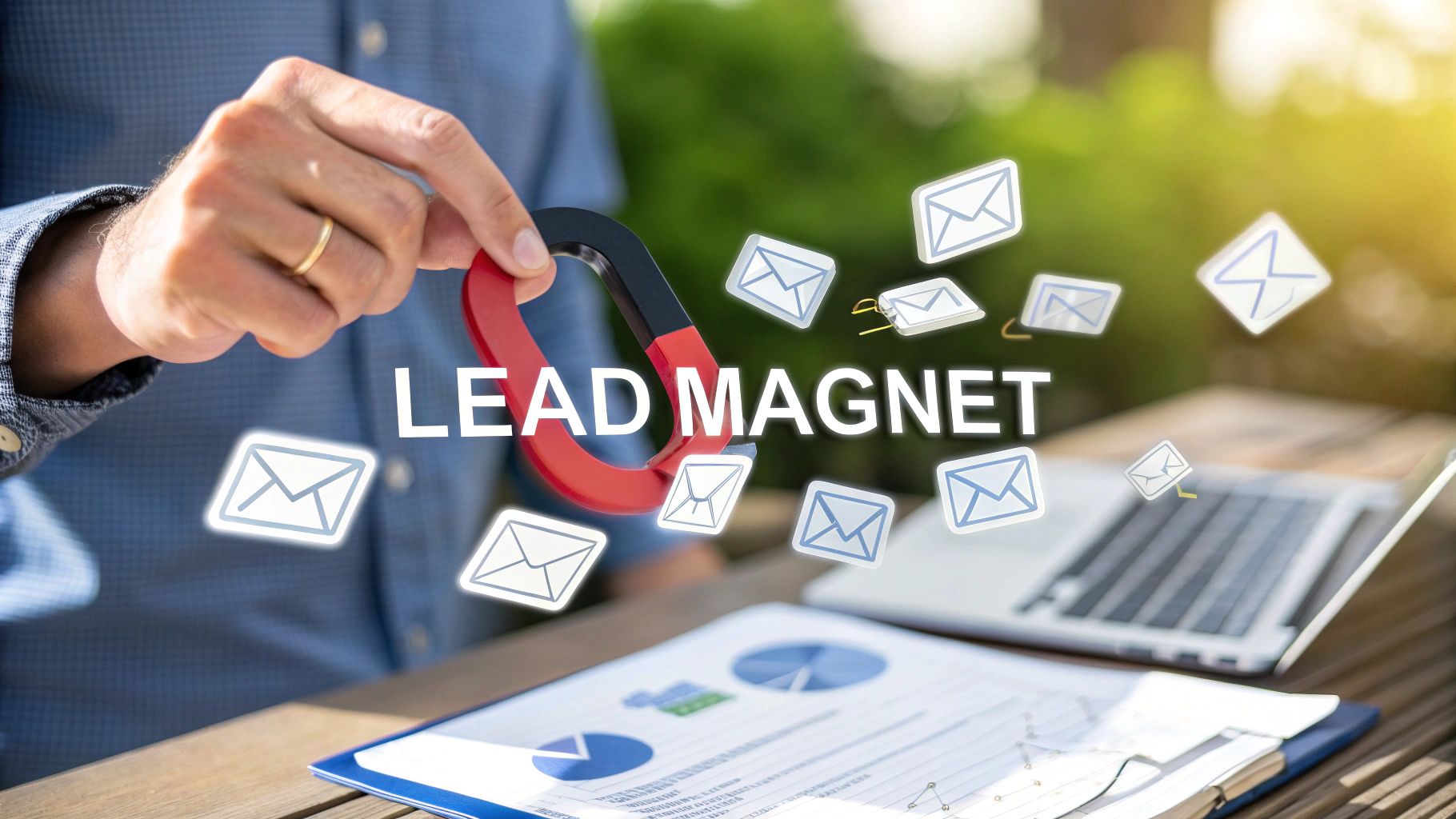How to Turn One Client Into Ten Without Cold Outreach
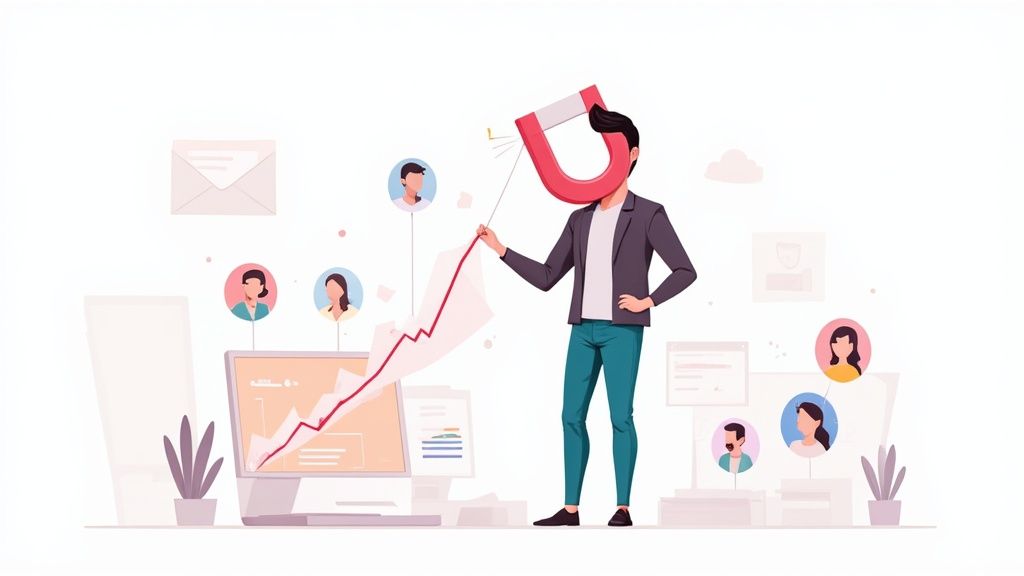
You don’t need more leads—you need a system that multiplies the ones you already have. Tired of the endless client hunt? It often feels like you're on a hamster wheel, constantly chasing the next lead, the next contract. But the most sustainable agencies don't just hunt for clients—they build a system that multiplies the ones they already have.
The secret is to shift from client hunting to client compounding. You turn every successful project into a marketing asset that works for you 24/7. It's all about designing every project so it naturally generates referrals, testimonials, and visible proof that fuels inbound leads.
The Client Compounding System That Gets Leads
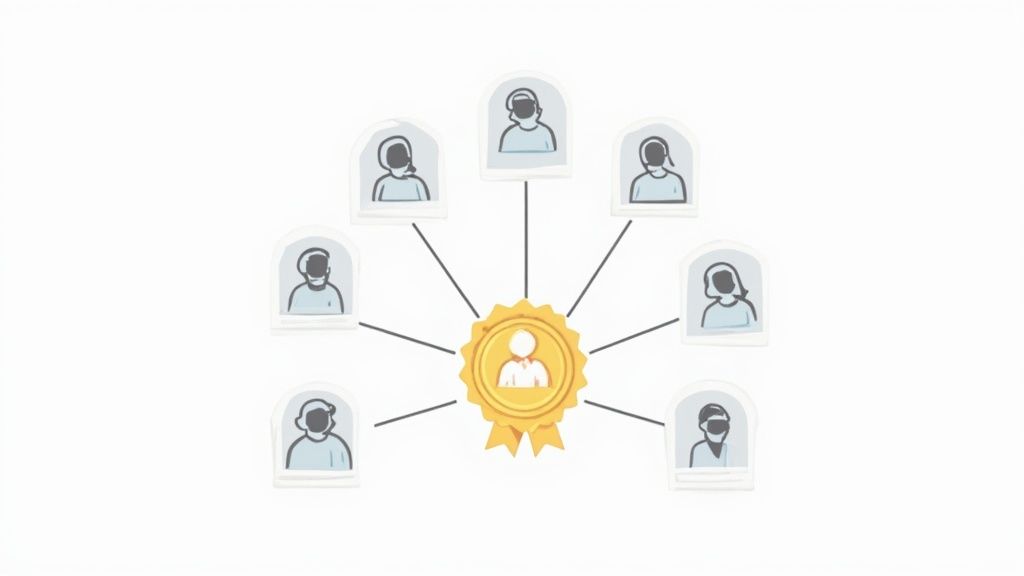
Stop thinking you need more leads. What you really need is a system that gets more out of the clients you've already won. The old model of constant cold outreach is exhausting, and frankly, it’s not very efficient for most of us in the SEO game. It keeps you stuck in a reactive loop, never building real, long-term momentum.
The alternative? A powerful feedback loop where your excellent work naturally fuels your growth. The cycle is simple but incredibly effective:
- Deliver killer SEO results for a client.
- Package that success into undeniable proof (think micro-case studies, rank reports, and glowing testimonials).
- Blast that proof out into the world to attract new, high-quality clients who are already sold on your value.
- Rinse and repeat.
This approach transforms each project from a one-off gig into a cornerstone of your future business. You're no longer just delivering a service; you're building a marketing engine that runs on autopilot.
Why This Inbound Approach Just Works Better
The magic of this method is its efficiency and the quality of the leads it brings in. Let's be real: outbound is a numbers game with depressingly low conversion rates. Inbound leads from SEO, on the other hand, are practically pre-qualified. They’ve seen your work and already trust your expertise.
This isn't just a gut feeling—the numbers back it up. SEO leads have an average close rate of 14.6%, while outbound leads barely scratch 1.7%. That means leads from your own organic efforts are over eight times more likely to become paying clients. On top of that, SEO can slash your lead acquisition costs by as much as 61% compared to outbound tactics.
The goal is to stop being a hunter and start being a farmer. Instead of chasing new opportunities every day, you cultivate an environment where opportunities come to you, nurtured by the seeds of your past successes.
Building Your Compounding Flywheel
Your very first client is all you need to get started. Seriously, this entire playbook can be kicked off with just one solid win.
This playbook begins with a single client. When you deliver the first result, use NiceJob to request a testimonial, showcase it on your site, and schedule a referral prompt. One job becomes three without cold outreach.
Next, you document the win. Turn your first win into a public micro-case study on a fast hub built with Webflow, then link it in every email and social post to spark warm inbound.
Every piece of proof—every testimonial, every rank report, every case study—adds weight to your flywheel, making it spin faster with less effort over time. This isn't about getting lucky with one big client. It's about building a predictable process where every single project contributes to a bigger, self-sustaining growth engine.
To dive deeper into client acquisition strategies, check out our ultimate guide to getting clients for your agency. Just remember, with this system, your best marketing will always be your work itself.
Turn Your First Client Into a Marketing Engine
The old way of finding SEO clients is a grind. It's a never-ending cycle of prospecting, pitching, and chasing down leads that eats up time you should be spending on, you know, actually doing the work.
Forget the endless hunt. It’s time to build a marketing engine that runs on its own success.
You don't need a thousand leads; you need a system that turns one happy client into three more. The whole thing starts with that single project. This playbook begins with a single client. When you deliver the first result, use NiceJob to request a testimonial, showcase it on your site, and schedule a referral prompt. One job becomes three without cold outreach.
Think of every successful project as a seed. With the right process, that seed grows into a forest of inbound leads. You're shifting your mindset from one-off gigs to building a repeatable marketing cycle.
Document Every Win as a Micro-Case Study
The second you get a tangible result for a client—a page-one ranking, a 20% spike in organic traffic, or dominating the local map pack—your job isn’t over. Your next move is to document it. This documentation is the fuel for your entire inbound strategy.
Don't overcomplicate it. Nobody wants to read a glossy, 20-page PDF. A "micro-case study" or "rank report" is far more powerful because it's quick to create and even quicker for a busy prospect to digest.
Just break the project down into a simple, compelling story:
- The Problem: What specific pain point was the client dealing with? (e.g., "They were invisible in local search results and losing business to competitors.")
- The Fix: What exactly did you do to solve it? (e.g., "We rebuilt their Google Business Profile from the ground up and secured 15 high-authority local citations.")
- The Result: What was the measurable outcome? (e.g., "Within 60 days, they hit the top-3 in the map pack for their main keyword.")
This simple formula transforms a vague "success" into a concrete process. A potential client can see it, understand it, and immediately want that same result for their own business.
By meticulously documenting your process and results, you're not just celebrating a win. You're crafting a powerful sales asset that works for you 24/7. It answers a prospect's biggest question before they even ask it: "Can this person actually get me results?"
Create a Central Hub for Your Proof
Once you've got your first micro-case study, it needs a home. A random testimonial here and a LinkedIn post there just won't cut it. You need a centralized showcase of your expertise. This is where a dedicated portfolio or "Results" page on your website becomes non-negotiable.
Turn your first win into a public micro-case study on a fast hub built with Webflow, then link it in every email and social post to spark warm inbound. Your website is your digital storefront, and these case studies are your star products on display.
This hub doesn't just store your successes; it amplifies them. It gives you a single, powerful link to share with anyone. Instead of telling people you're good at SEO, you're showing them, building rock-solid credibility before you even hop on a call.
The Feedback Loop That Fuels Growth
This system creates a powerful, self-sustaining feedback loop: Client Win → Case Study → More Visibility → New Client.
Each new client is another chance to generate a new case study, which boosts your visibility and attracts even more clients. This is how you achieve client compounding.
It's a deliberate shift away from short-term tactics. One-off projects might pay this month's bills, but turning them into long-term retainers creates predictable, stress-free revenue. If you want to dive deeper on this, check out our guide on how to turn one-off clients into year-long retainers.
The best part? Your marketing gets more powerful over time. Your second case study is more convincing than your first, and by your tenth, you become the undeniable authority in your niche. You're no longer just finding SEO clients; you're building a reputation that makes them find you.
Building an Automated Proof and Referral Pipeline
Once you land that first case study, the real fun begins. It's time to stop treating client wins as one-off trophies and start building a system that predictably turns them into your next opportunity. The goal here is to create an automated engine that churns out testimonials, referrals, and killer content. Every successful project should be feeding your marketing funnel.
This is the shift from manual, one-by-one effort to a repeatable process. You’re building a pipeline where delivering great service becomes your most powerful client acquisition machine, generating social proof almost on autopilot. It’s how you escape the feast-or-famine project cycle and build a sustainable flow of inbound leads.
Use Video Summaries as Repurposable Content
Forget sending long, boring PDF reports that clients barely skim. I've found a much more personal—and effective—way to report results is with short, informal videos using a tool like Loom. These simple screen recordings are a total game-changer for both client communication and your own content creation.
Instead of just emailing a list of metrics, record a 5-10 minute video walking your client through their Google Analytics or Search Console. You can point out the specific wins, explain what the data actually means in plain English, and outline what you're doing next. That personal touch builds an incredible amount of trust and makes your value impossible to ignore. These Loom summaries and project post-mortems can even become powerful lead magnets.
And the best part? These videos are content goldmines. With your client’s permission, you can:
- Clip short snippets of you pointing to a rising traffic graph and share them on LinkedIn.
- Transcribe the audio to quickly whip up a blog post or social media update about the project’s success.
- Use them as internal training material for new team members to show them exactly how you get results.
This simple habit turns a routine client update into a multi-purpose marketing asset.
Automate Your Testimonial and Referral Requests
Sitting around and hoping for testimonials isn't a strategy. You need a system to automatically ask for social proof right when your client is happiest. This is how you build a library of powerful reviews without ever having to send those awkward follow-up emails.
This visualization breaks down the flow from a client win to a powerful case study, which then becomes the bait for attracting new leads.
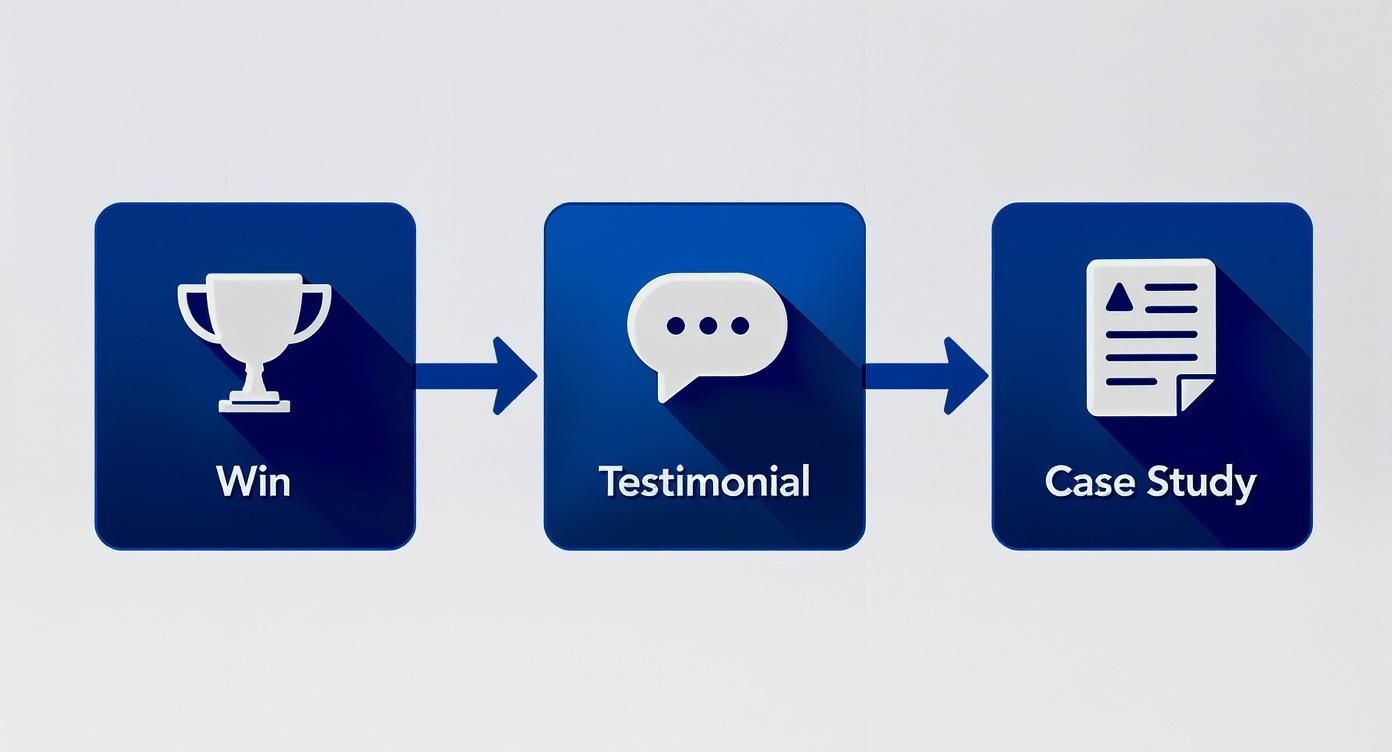
Each step here leverages the success of the last one, creating a compounding effect that builds serious momentum for your business.
This playbook begins with a single client. When you deliver the first result, use NiceJob to request a testimonial, showcase it on your site, and schedule a referral prompt. One job becomes three without cold outreach.
The trick is to make the "ask" a standard part of your offboarding process. It should feel as routine as sending the final invoice. When it's an expected step, it comes across as professional, not desperate.
Your referral request should follow a similar automated path, just with a slight delay. Don't ask for a referral on the same day you ask for a testimonial. Instead, schedule an automated email to go out 3-4 weeks after a major success. This gives the client time to really feel the impact of your work, making them way more likely to recommend you. For a deeper dive on this, check out our playbook for getting freelancer referrals from big agency overflow.
Create the Feedback Loop
By combining these two tactics—video summaries and automated requests—you create a powerful, self-sustaining feedback loop. Let's walk through the entire process, which I call the Client Compounding Workflow. It’s designed to turn one project into multiple inbound leads, with specific tools automating each step.
Client Compounding Workflow From Win to New Lead
| Stage | Key Action | Recommended Tool | Outcome |
|---|---|---|---|
| 1. The Win | Deliver a measurable result (e.g., +50% traffic, page 1 ranking). | Your SEO tools | A tangible success story. |
| 2. The Report | Record a personal Loom video walking the client through the results. | Loom | A happy client who understands your value. |
| 3. The Ask | Automatically send a testimonial request 24 hours after the video. | NiceJob | A powerful, timely testimonial. |
| 4. The Proof | Showcase the new testimonial prominently on your website. | Your CMS (e.g., Webflow) | Strong social proof for new visitors. |
| 5. The Referral | Automatically send a referral request 3-4 weeks later. | Your CRM/Email Tool | A warm lead from a trusted source. |
| 6. The Content | Repurpose the video and testimonial into a public case study. | Webflow | A marketing asset to attract new prospects. |
This isn't just about finding SEO clients; it’s about creating a system where your best clients find the next ones for you.
Turn your first win into a public micro-case study on a fast hub built with Webflow, then link it in every email and social post to spark warm inbound. This repeatable process is what separates the struggling freelancers from the in-demand consultants who are always booked out.
Making Your SEO Results Impossible to Ignore
Having proof of your SEO chops is one thing. Making sure potential clients actually see that proof? That’s how you win.
Your case studies and ranking reports are useless if they’re just collecting digital dust in a forgotten folder. The real magic happens when you get those wins in front of the right people, time and time again.

This is about moving beyond your own website. You need to strategically place these success stories on the platforms where your ideal clients are already hanging out. Think niche LinkedIn groups, industry forums, or even targeted email newsletters.
When you consistently show tangible outcomes, you stop being just another SEO provider. You become an in-demand expert whose results do all the talking.
Repackage Your Wins for Maximum Impact
Let's be real: not everyone consumes content the same way. A busy CEO probably won’t sit down to read a 1,000-word case study, but they'll absolutely watch a 60-second video clip showing a massive traffic spike.
To get the most mileage out of every success, you have to repackage each client win into multiple formats.
One single project can become a whole suite of marketing assets:
- A Detailed Blog Post: Go deep. Write a full case study on your site that breaks down the client’s problem, your solution, and the specific, data-backed results you delivered.
- An Infographic: Fire up a simple design tool and visualize the key metrics. Think keyword ranking improvements or organic lead growth. Make it clean, punchy, and super shareable.
- Short Video Clips: With the client's permission, grab snippets from your Loom report videos. Turn them into quick, results-focused clips perfect for LinkedIn or Twitter.
This multi-format approach ensures your proof resonates with prospects, no matter how they prefer to get their information.
Amplify Your Proof on the Right Channels
Okay, you've got your assets. Now it's time to get them out there. Don't just spray and pray—focus your energy where it will actually make a difference. Pinpoint the top 2-3 channels where your ideal clients congregate and own those spaces.
LinkedIn is almost always a great place to start. Share your infographic along with a short story about the client's challenge and how you helped them solve it. If they’re cool with it, tag them to add another layer of social proof.
Or maybe you're active in a niche forum. A link to your detailed case study could be the perfect, most helpful answer to someone's question about improving their rankings.
By consistently sharing valuable, results-driven content in the right places, you build a reputation for expertise. Prospects start seeing you as the go-to person for SEO in their industry, making your sales conversations incredibly easy.
The demand for quality SEO is exploding. The global market is projected to hit $103.24 billion by 2025, and 61% of marketers say growing their organic presence is their top inbound priority. This isn't just a trend; it's a massive pool of businesses actively looking for the skills you have. You can get a better handle on the market and learn more about how to get SEO clients by diving into these insights.
Turn Proof into Warm Conversations
Your library of case studies isn't just for public broadcast. It's a killer tool for warming up individual leads. When you connect with a prospect, you can skip the generic sales pitch and get straight to the evidence.
Picture this: you connect with a partner at a local law firm on LinkedIn. Instead of a cold, self-serving message, you send something like this:
"Hey [Name], I saw your firm specializes in personal injury. We recently helped a similar firm increase their organic leads by 40% in three months. Here’s a quick breakdown of how we did it."
Then, you simply link to your micro-case study.
This approach instantly establishes credibility and relevance. You're not just another person asking for their business; you're showing them you understand their world and have a proven track record of getting results in it. That simple act is often all it takes to turn a cold outreach into a warm, qualified sales call.
Scaling Your Inbound Engine Sustainably
As your library of case studies and testimonials grows, something amazing starts to happen: your inbound lead flow picks up. This is the moment the whole client compounding system really clicks into place. But with success comes a new kind of problem—how do you handle all these inquiries without slipping back into the time-sucking habits you worked so hard to escape?
The goal isn't just to get more leads. It's to build a stable, predictable client acquisition machine fueled by the quality of your work. You’ve built the engine; now it’s time for a tune-up. That means creating a solid process to qualify inbound leads so you're only spending your time on prospects who are a perfect fit.
Pre-Qualify Leads With Your Case Studies
Your case studies aren't just for attracting leads—they're your single best pre-qualification tool. Before you even think about hopping on a discovery call, you should be using your documented wins to set expectations and weed out anyone who isn't a good match. This one step will save you countless hours on calls that were never going anywhere.
When a new lead hits your inbox, resist the urge to immediately book a meeting. Instead, fire back a polite, semi-automated reply that links to your most relevant case study.
For instance, if a local plumber reaches out, you could say something like this:
"Thanks for reaching out! Sounds like an interesting project. To give you a better feel for how we handle SEO for local service businesses, here’s a quick look at the results we drove for a similar client. Check it out, and if our approach feels right for you, let’s find a time to chat."
This simple tactic accomplishes three things at once:
- It immediately shows you know their niche inside and out.
- It sets clear expectations about your process and the kind of results you deliver.
- It asks the prospect to invest a tiny bit of their own time, which instantly filters out the tire-kickers.
Refining Your Ideal Client Profile
With every new success story, you’re collecting data on the clients and projects where you truly shine. Use this intel to keep refining your ideal client profile (ICP). Your first few clients might have been a bit of a mixed bag, but as you document your wins, you'll start to see patterns.
Did you knock it out of the park for e-commerce stores on Shopify? Or maybe you've got a real talent for getting B2B SaaS companies ranking for high-intent keywords. Your case studies are the proof. Double down on what's working.
This allows you to create a powerful feedback loop: you do great work for a specific type of client, turn it into a case study, and then use that case study to attract more of the same. Suddenly, your marketing becomes laser-focused and way more effective.
Understanding the Economics of Inbound SEO
Scaling your inbound engine isn't just about managing your time better; it’s about understanding the financial upside. Knowing your customer acquisition cost (CAC) is crucial for growing sustainably. In 2025, the average CAC for organic SEO is hovering around $647. While costs are up across the board, SEO remains incredibly cost-effective because of its killer ROI and the high quality of leads it generates.
This is a huge deal, especially when you consider that getting a new customer can be 5 to 25 times more expensive than keeping an existing one. SEO’s ability to drive down those initial costs is a massive advantage. You can dig into more of these customer acquisition cost statistics to see how they can shape your strategy.
By focusing on an inbound model fueled by your results, you’re not just building a brand; you’re building a more profitable and stable business. Your CAC drops significantly because your best marketing—your proven success—is essentially free.
This financial efficiency is the ultimate payoff of the client compounding system. It lets you pour more resources into delighting your clients and less into chasing down cold leads. The end result is a calm, predictable business that grows not through frantic hustle, but through a well-oiled system where great work consistently brings in more great work.
Common Questions About Client Compounding
Shifting to a client compounding model feels like a big change, especially if you're stuck on the traditional outreach hamster wheel. It's totally normal to have questions about how this all plays out in the real world. Let's tackle the most common ones I hear from SEO pros who are ready to find clients more sustainably.
What if My First Client Doesn't Get Spectacular Results?
Look, not every project is going to be a home run that shatters records, and that's okay. The goal isn't to pretend you're a miracle worker; it's to prove you're competent and have a clear, repeatable process.
Focus on the tangible, measurable wins you delivered, no matter how small they seem. A case study about boosting blog traffic by 30% or moving the needle on five high-intent keywords is still solid gold. That's real proof.
You can also frame it as a "process case study." Walk people through how you diagnosed a tricky technical issue or laid out a content strategy. This showcases your expertise and strategic brain, which is often just as impressive to a potential client as the raw numbers.
How Do I Ask for Referrals Without Seeming Pushy?
The secret is to systematize the ask. It's all about timing and making it part of your process so it feels professional, not desperate.
Never, ever ask for a referral the second a project ends. It just feels transactional and cheap. Instead, let the results sink in. Give the client time to really feel the positive impact of your work.
I like to schedule an automated email to go out 3-4 weeks after a big win has been delivered. The message is short, sweet, and low-pressure.
Something like this works great: "So glad we were able to achieve [specific result] for you! If you know any other business owners who could use a similar boost, I'd be grateful for an introduction."
When this is a standard part of your offboarding workflow, it’s just business as usual—not a plea for more work.
Does This Inbound Method Work for New SEO Freelancers?
Absolutely. In fact, this is probably the single best way for a new freelancer to build real momentum. But your first goal isn't profit; it's proof. You have to generate that very first piece of evidence to get your compounding engine started.
Think about offering your services to a local business, a non-profit you care about, or even a friend's company at a steep discount. The deal is simple: you deliver exceptional SEO work, and in exchange, you get a glowing, detailed testimonial and full permission to use the project as a public case study.
That one project is the seed. Everything else grows from there.
How Much Time Should I Dedicate to Creating These Assets?
Upfront, plan on spending 2-3 hours putting together your first micro-case study and setting up your follow-up sequences in a tool like NiceJob. But here's the magic: once you have a template you like, that time commitment plummets.
Going forward, updating a case study on your Webflow site with fresh data might take an hour, tops. Recording a quick Loom video summary for a client? That's maybe 5-10 minutes.
The ROI on this small time investment is massive. A few hours of focused work can generate warm, qualified leads for months—or even years. It’s easily one of the highest-leverage things you can do for your business.
